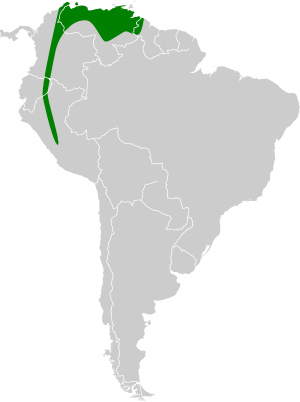Broad-toothed tailless bat facts for kids
Quick facts for kids Broad-toothed tailless bat |
|
|---|---|
| Conservation status | |
| Scientific classification | |
| Genus: |
Anoura
|
| Species: |
latidens
|
 |
|
| Distribution | |
The broad-toothed tailless bat (Anoura latidens) is a type of bat that belongs to the family Phyllostomidae. These bats can be found in several South American countries, including Colombia, Peru, and Venezuela.
Contents
What is a Broad-toothed Tailless Bat?
The broad-toothed tailless bat is a fascinating creature. It gets its name from its unique teeth and the fact that it has a very short tail, or sometimes no visible tail at all. Bats are the only mammals that can truly fly, and they play many important roles in their ecosystems.
Where Do These Bats Live?
Broad-toothed tailless bats live in tropical and subtropical regions. They prefer areas with dense forests, often near mountains or highlands. Their homes can be found in caves, hollow trees, or even abandoned buildings. These places offer them safe spots to rest during the day and raise their young.
Bat Habitats in South America
In Colombia, Peru, and Venezuela, these bats live in diverse environments. This includes cloud forests and humid lowlands. They need healthy forests to find food and shelter. Protecting these habitats is very important for the bats to survive.
What Do Broad-toothed Tailless Bats Eat?
Many bats are insect-eaters, but the broad-toothed tailless bat is different. It is mainly a nectarivore, which means it feeds on nectar from flowers. They also eat pollen and sometimes small insects.
How Do They Find Food?
These bats have long tongues that are perfect for reaching deep into flowers to get nectar. As they feed, pollen sticks to their fur. When they visit another flower, they help spread the pollen. This process is called pollination, and it is very important for many plants to reproduce.
The Importance of Pollination
Pollination by bats helps many plants, including some that produce fruits we eat. Without bats, these plants might not be able to grow. This shows how important bats are to the health of our planet's ecosystems.
Bat Behavior and Lifestyle
Broad-toothed tailless bats are nocturnal, meaning they are active at night. During the day, they rest in their roosts. They often live in groups, which can range from a few bats to hundreds.
How Do Bats See in the Dark?
Bats use a special ability called echolocation to navigate and find food in the dark. They send out high-pitched sounds. These sounds bounce off objects and create echoes. The bats listen to these echoes to create a "sound map" of their surroundings. This helps them avoid obstacles and locate flowers or insects.
Raising Bat Pups
Female bats usually give birth to one pup at a time. The mother bat cares for her pup, feeding it milk until it is old enough to fly and find its own food. Bat pups grow quickly and soon learn to use echolocation and fly.
Conservation Status
The broad-toothed tailless bat is currently listed as "Least Concern" by the International Union for Conservation of Nature (IUCN). This means their populations are stable for now. However, like many bat species, they face threats.
Threats to Bats
Some threats to bats include habitat loss due to deforestation. Pesticides used in farming can also harm them by reducing their food sources or poisoning them. Climate change is another concern, as it can alter their habitats and food availability.
Why Protect Bats?
Protecting bats is important for many reasons. They help pollinate plants, control insect populations, and spread seeds. By understanding and protecting bats, we help keep our natural world healthy and balanced.
See also
 In Spanish: Anoura latidens para niños
In Spanish: Anoura latidens para niños


